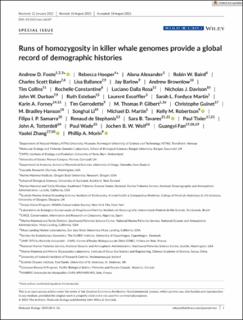Runs of homozygosity in killer whale genomes provide a global record of demographic histories
| dc.contributor.author | Foote, Andrew | |
| dc.contributor.author | Hooper, Rebecca | |
| dc.contributor.author | Alexander, Alana | |
| dc.contributor.author | Baird, Robin | |
| dc.contributor.author | Baker, Scott | |
| dc.contributor.author | Ballance, Lisa | |
| dc.contributor.author | Barlow, Jay | |
| dc.contributor.author | Brownlow, Andrew | |
| dc.contributor.author | Collins, Tim | |
| dc.contributor.author | Constantine, Rochelle | |
| dc.contributor.author | Rosa, Luciano Dalla | |
| dc.contributor.author | Davison, Nicholas J. | |
| dc.contributor.author | Durban, John | |
| dc.contributor.author | Esteban, Ruth | |
| dc.contributor.author | Excoffier, Laurent | |
| dc.contributor.author | Forney, Karin A. | |
| dc.contributor.author | Gerrodette, Tim | |
| dc.contributor.author | Gilbert, Marcus Thomas Pius | |
| dc.contributor.author | Guinet, Christophe | |
| dc.contributor.author | Hanson, M. Bradley | |
| dc.contributor.author | Li, Songhai | |
| dc.contributor.author | Martin, Sarah | |
| dc.contributor.author | Martin, Michael David | |
| dc.contributor.author | Robertson, Kelly M. | |
| dc.contributor.author | Samarra, Filipa I.P. | |
| dc.contributor.author | de Stephanis, Renaud | |
| dc.contributor.author | Tavares, Sara B. | |
| dc.contributor.author | Tixier, Paul | |
| dc.contributor.author | Totterdell, John A. | |
| dc.contributor.author | Wade, Paul | |
| dc.contributor.author | Wolf, Jochen B.W. | |
| dc.contributor.author | Fan, Guangyi | |
| dc.contributor.author | Zhang, Yaolei | |
| dc.contributor.author | Morin, Phillip A. | |
| dc.date.accessioned | 2021-09-17T06:28:18Z | |
| dc.date.available | 2021-09-17T06:28:18Z | |
| dc.date.created | 2021-08-21T14:09:52Z | |
| dc.date.issued | 2021 | |
| dc.identifier.issn | 0962-1083 | |
| dc.identifier.uri | https://hdl.handle.net/11250/2778770 | |
| dc.description.abstract | Runs of homozygosity (ROH) occur when offspring inherit haplotypes that are identical by descent from each parent. Length distributions of ROH are informative about population history; specifically, the probability of inbreeding mediated by mating system and/or population demography. Here, we investigated whether variation in killer whale (Orcinus orca) demographic history is reflected in genome-wide heterozygosity and ROH length distributions, using a global data set of 26 genomes representative of geographic and ecotypic variation in this species, and two F1 admixed individuals with Pacific-Atlantic parentage. We first reconstructed demographic history for each population as changes in effective population size through time using the pairwise sequential Markovian coalescent (PSMC) method. We found a subset of populations declined in effective population size during the Late Pleistocene, while others had more stable demography. Genomes inferred to have undergone ancestral declines in effective population size, were autozygous at hundreds of short ROH (<1 Mb), reflecting high background relatedness due to coalescence of haplotypes deep within the pedigree. In contrast, longer and therefore younger ROH (>1.5 Mb) were found in low latitude populations, and populations of known conservation concern. These include a Scottish killer whale, for which 37.8% of the autosomes were comprised of ROH >1.5 Mb in length. The fate of this population, in which only two adult males have been sighted in the past five years, and zero fecundity over the last two decades, may be inextricably linked to its demographic history and consequential inbreeding depression. | en_US |
| dc.language.iso | eng | en_US |
| dc.publisher | Wiley | en_US |
| dc.rights | Navngivelse-Ikkekommersiell 4.0 Internasjonal | * |
| dc.rights.uri | http://creativecommons.org/licenses/by-nc/4.0/deed.no | * |
| dc.title | Runs of homozygosity in killer whale genomes provide a global record of demographic histories | en_US |
| dc.type | Peer reviewed | en_US |
| dc.type | Journal article | en_US |
| dc.description.version | publishedVersion | en_US |
| dc.source.journal | Molecular Ecology | en_US |
| dc.identifier.doi | 10.1111/mec.16137 | |
| dc.identifier.cristin | 1927812 | |
| cristin.ispublished | true | |
| cristin.fulltext | postprint | |
| cristin.qualitycode | 2 |
Tilhørende fil(er)
Denne innførselen finnes i følgende samling(er)
-
Institutt for naturhistorie [1213]
-
Publikasjoner fra CRIStin - NTNU [37219]

